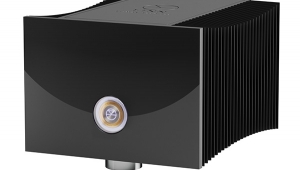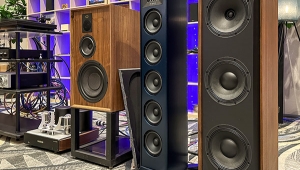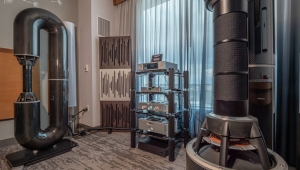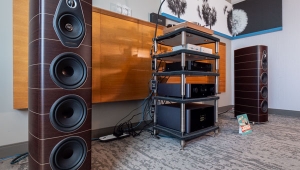| Columns Retired Columns & Blogs |
Apogee Stage & Mini-Grand loudspeakers Mini-Grand part 4
I wanted it all. To try and get it, I pulled out the stops and tried the "Rule of Thirds"—something for which I've never before had the space. Simply put, the Rule of Thirds requires you to place the loudspeakers one-third of the room length out from the front wall, with the listener one-third of the room length from the rear wall. You don't need a calculator to figure out that this requires either a very long room or a very intimate relationship with your loudspeakers. Since my new room is just under 26' long, it was a practical alterative. "This can't work," I thought, as I was sitting much closer to the Mini-Grands than I had been before.
But it did work. The loudspeakers themselves nearly disappeared as discrete soundsources. The soundstage was immense, with a layered depth stretching beyond anything I'd previously heard from the Mini-Grands or the Stages alone. Imaging precision, while not in the minimonitor class, was nevertheless convincingly real. The mid-treble was now smoother, less prominent. While this characteristic didn't disappear completely, the added distance to the wall behind the loudspeakers was clearly having a positive effect on the overall balance. And the bass? The sound was now decidedly warmer, but in a positive way—a bit less of the extended minimonitor bass, a bit more of the Stages-alone-in-the-Stereophile-listening-room quality.
Measurements similar to those described above showed an increased emphasis in the 50-60Hz region and less extension at the extreme bottom. But what I heard was decidedly more impressive than that. The string bass sound on Impending Bloom (Justice JR0801-2)—a superbly recorded female vocal and double-bass compilation of what has been described as "Twin Peaks" arrangements (Corey Greenberg would have a seizure if he heard the version of "Heartbreak Hotel" here)—was dynamic and punchy, yet had an irresistible, full-bodied richness.
The extended bottom end on the Jurassic Park (MCA MCAD-10859) and The Abyss (Varèse Sarabande VSD-5235) soundtracks was dramatically charged—particularly on The Abyss. The room was loaded up with bass I could feel and hear, adding real drama to the music. And the sense of space on Enya's Watermark (Geffen 24233-2) was nearly overwhelming—the bass almost rocked that slab floor, particularly on "The Long Ships," in which the bass punctuation, deeply placed in the layered soundstage, provided a real foundation for the piece, notably near the end where the drum strokes are doubled. The Mini-Grands took no prisoners.
Was this the absolute best placement for the Mini-Grands in this room? Maybe yes, maybe no. But there's no escaping the irony of my initial efforts to optimize the placement of the Stages alone, only to find that a radical placement solution which never occurred to me earlier in the listening tests turned out to improve the overall performance. I still would have liked to have tamed the midbass a bit while also bringing up the bottom end a bit more, but the Rule of Thirds position turned out to be a very satisfying solution; I kept the Mini-Grands there for the duration of the tests. I did try reversing the subwoofers' electrical polarity again (back to all positive) in this new location, but found that this raised the level of the entire bottom end below 200Hz to an unacceptable degree.
This does not necessarily mean that this sort of positioning will be best for your situation, which is fortunate—it's not really practical for most rooms. Even if your room is big enough, such a setup pretty much turns the room into a dedicated listening room. But in most average rooms there'll be a reasonable solution. Experiment. And don't be afraid to try locations that might look a bit crazy. I would, however, take Apogee's 3' minimum spacing from the rear wall quite seriously.
Power problems
I encountered one troubling problem with the Mini-Grands' subwoofer: power handling. With the admittedly very powerful KSA-300S driving the subwoofers, I encountered a few too many instances of woofer overload. I first noticed an alarming degree of very-low-frequency subwoofer driver pumping on a number of recordings. Those 8" cones do have an impressive excursion capability, however, and though they appeared to be working their little tushes off, woofer bottoming from this alone was rare. To ensure that something else in the system wasn't causing this problem—which only occurred with a recording playing—I swapped preamps, CD players, and amplifiers (initially swapping the KSA-300S driving the Stages and subwoofers, later substituting a Hafler 9500 as the subwoofer amp). The fluttering continued. One of the subwoofer drivers in each cabinet seemed to be more prone to overloading than the other—though only on extreme excursions, and not to such a degree that I would suspect out-of-spec drivers.
But the overload didn't seem to be directly related to the driver pumping: it sometimes occurred on recordings which produced no pumping, and sometimes was no problem on recordings which did pump. It was only a problem on the most challenging recordings. (For instance: the lead-in drum attacks on Jurassic Park; the drum on "O Vazio" from Tropic Affair, Reference RR-31CD; the lowest bass growlings in The Abyss and Pictures at an Exhibition; the falling drumset on Däfos, Reference RR-12CD; and the final "Rhinefalls" cut on Staccato 2, German Audio magazine CD 101013. The last is a genuine torture test I wouldn't fault any loudspeaker for failing.)
- Log in or register to post comments




































